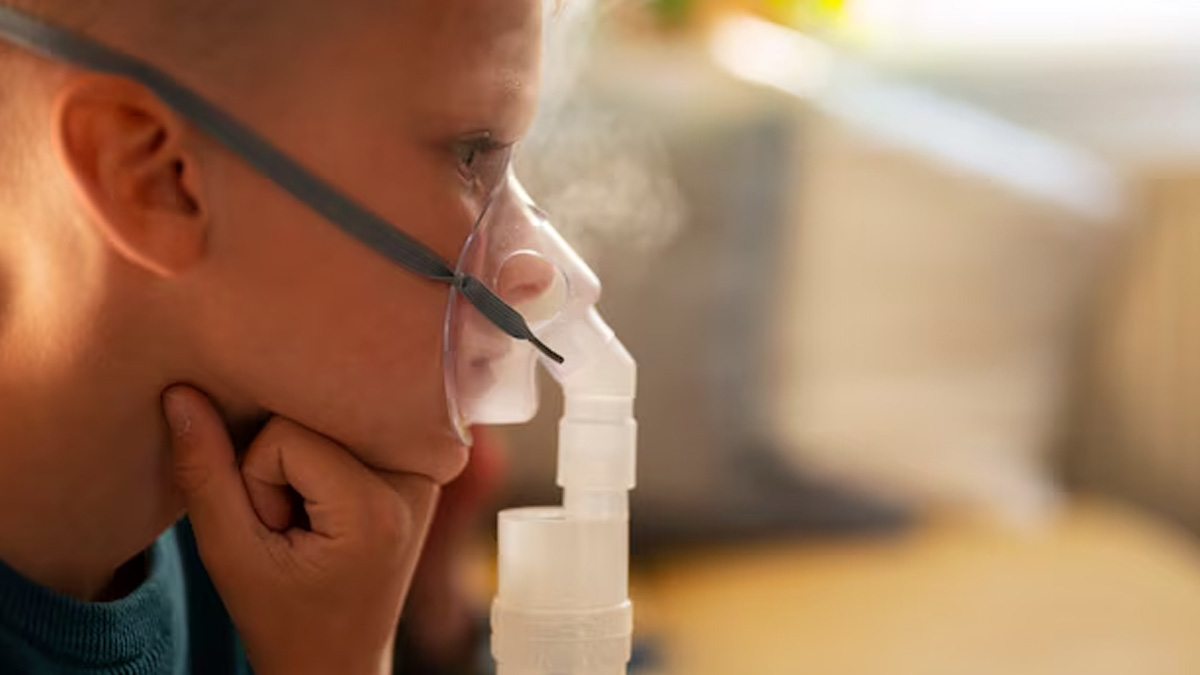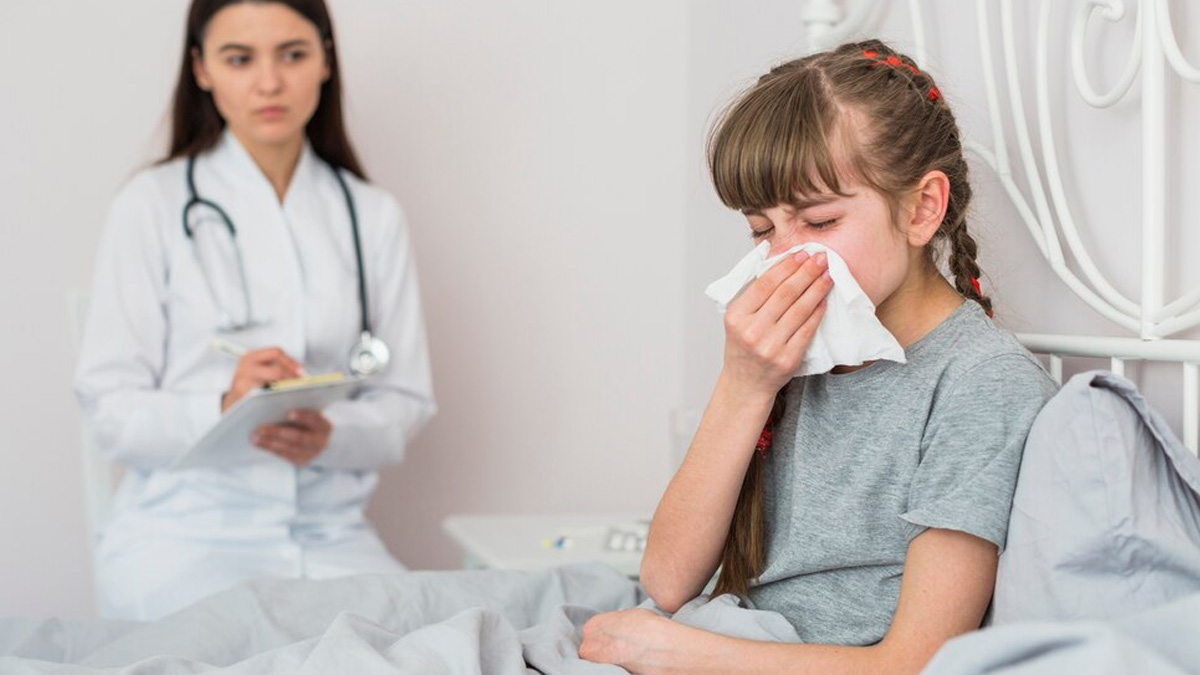
Respiratory diseases are a leading cause of illness in children, often causing significant distress and concern for parents. Understanding these conditions, their symptoms, and treatment options can help manage and prevent complications. Here are seven common childhood respiratory diseases:
Table of Content:-
Common Cold
Talking to the Onlymyhealth team, Dr Shashidhar, TB, Head - Surgery (ENT), Artemis Hospitals, Gurgaon, said, “The common cold is a viral infection that affects the upper respiratory tract, including the nose and throat. It is caused by various viruses, with rhinoviruses being the most common culprits.” She listed the symptoms of the common cold:
- Runny or stuffy nose
- Sore throat
- Cough
- Sneezing
- Mild fever
A study published in the official journal of The College of Family Physicians of Canada reports that children average 6-8 colds per year. The study highlights that ‘since colds occur throughout the year, their overall impact on health is more significant than that of seasonal influenza. Colds are responsible for 30% of school absenteeism.’
Dr Shashidhar listed the ways common cold is treated:
- Rest and hydration
- Over-the-counter medications for fever and pain
- Nasal saline drops to relieve congestion

Bronchiolitis
An overview by researchers from the East Tennessee State University and Desert Regional Medical Center defines bronchiolitis as an infection of the small airways in the lungs, typically caused by the respiratory syncytial virus (RSV). It primarily affects infants and young children.
The symptoms of bronchiolitis are:
- Wheezing
- Rapid breathing
- Cough
- Difficulty feeding
- Fever
To treat bronchiolitis in children, doctors typically recommend ensuring adequate fluid intake, using a humidifier to moisten the air, and hospitalisation in severe cases for oxygen therapy and hydration.
Asthma
“Asthma is a chronic condition characterised by inflammation and narrowing of the airways, leading to difficulty breathing. Allergens, infections, or physical activity can trigger it,” said Dr Sunil Kumar Gonuguntala, Neonatologist, Apollo Cradle and Children’s Hospital, Marathahalli, Bengaluru.
The main symptoms of asthma in children are:
- Wheezing
- Shortness of breath
- Chest tightness
- Cough, especially at night
According to the Asthma and Allergy Foundation of America, In 2021, 38.7% of children aged 18 and younger with asthma experienced one or more asthma attacks over the past year. Among children under the age of 5 with asthma, approximately 63.1% had an attack.
Dr Gonuguntala listed the ways asthma is treated in children:
- Inhaled corticosteroids to reduce inflammation
- Bronchodilators for quick relief during an asthma attack
- Identifying and avoiding triggers

Pneumonia
Dr Shuchin Bajaj, Founder and Director, Ujala Cygnus Group of Hospitals told the Onlymyhealth team, “Pneumonia is an infection that inflames the air sacs in one or both lungs. It can be caused by viruses, bacteria, or fungi, ranging from mild to severe.” The symptoms of pneumonia in children are:
- High fever
- Cough with phlegm
- Rapid or laboured breathing
- Chest pain
- Fatigue
As per UNICEF data, globally, there are more than 1,400 pneumonia cases per 1 lakh children annually, equating to roughly 1 case per 71 children each year. The highest incidence rates are found in South Asia, with 2,500 cases per 1 lakh children, and in West and Central Africa, with 1,620 cases per 1 lakh children.
The way to treat pneumonia is:
- Antibiotics for bacterial pneumonia
- Antiviral medications for viral pneumonia
- Supportive care including fluids and rest
- Hospitalisation in severe cases for oxygen therapy
Whooping Cough (Pertussis)
“Whooping cough is a highly contagious bacterial infection caused by Bordetella pertussis. It is characterised by severe coughing fits followed by a high-pitched ‘whoop’ sound,” said Dr Manish Itolikar, Consultant Physician, Fortis Hospital, Mulund while in conversation with the Onlymyhealth team. The symptoms of whooping cough are:
- Severe coughing fits
- Whooping sound when inhaling
- Vomiting after coughing
- Exhaustion after coughing
Recently, whooping cough has been making a resurgence, making it a global issue. Despite high vaccination rates, whooping cough remains a major cause of infant mortality and a public health challenge worldwide, according to the World Health Organisation (WHO).
The best ways to treat whooping cough as per Dr Itolikar are:
- Antibiotics to treat the infection and prevent the spread
- Hospitalisation in severe cases for supportive care
- Vaccination to prevent the disease
Also Read: Can Food Allergies Be Prevented In Babies? Expert Shares How
Croup
Johns Hopkins Medicine defines croup as an infection that causes swelling around the vocal cords, leading to a characteristic barking cough. It is commonly caused by parainfluenza viruses, and its symptoms are:
- Barking cough
- Hoarseness
- Stridor (a high-pitched wheezing sound)
- Fever
As per the National Health Service, Croup is treated by:
- Humidified air or steam inhalation
- Keeping the child calm and comfortable
- Steroids to reduce airway inflammation
- Hospitalisation in severe cases for breathing support
Influenza (Flu)
Finally, Dr Brajesh Kunwar, Director of Interventional Cardiology, Fortis Hiranandani Hospital, Vashi spoke to the Onlymyhealth team sharing that “Influenza, commonly known as the flu, is a contagious respiratory illness caused by influenza viruses. It can cause mild to severe illness and sometimes lead to serious complications.” The symptoms of influenza are:
- High fever
- Chills
- Muscle aches
- Cough
- Sore throat
- Fatigue
According to the National Foundation for Infectious Diseases, Influenza (flu) is a serious illness that results in thousands of hospitalisations annually, with the majority occurring in children under the age of 5. On average, it is estimated that 20,000 children in this age group are hospitalised each year due to flu complications.
The best ways to treat Influenza in kids are:
- Antiviral medications if diagnosed early
- Rest and hydration
- Over-the-counter medications to relieve symptoms
Childhood respiratory diseases can be alarming, but understanding their symptoms and treatments can help parents manage them effectively. Preventive measures such as vaccinations, good hygiene practices, and avoiding known triggers can significantly reduce the risk of these illnesses. If your child shows signs of a respiratory condition, it is crucial to consult a healthcare provider for proper diagnosis and treatment.
Also watch this video
How we keep this article up to date:
We work with experts and keep a close eye on the latest in health and wellness. Whenever there is a new research or helpful information, we update our articles with accurate and useful advice.
Current Version